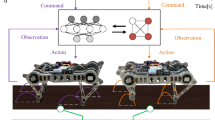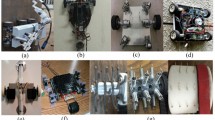Abstract
We present WCQR-III, an untethered bioinspired climbing robot capable of versatile locomotion, including ground walking, wall climbing and ground-to-wall transition. Inspired by gecko lizards, WCQR-III features a structure comprising four feet and one tail. The foot design incorporates a switching mechanism to seamlessly transition between walking and climbing modes. A spiny claw provides wall adhesion, while a rubber pad offers friction and cushioning for ground walking. Leveraging the screw theory, we establish a kinematic model to analyze the robot's mobility and transition ability. In the walking mode, a trotting gait is adopted, while the climbing mode introduces a detaching angle, pause, and backswing movement of spiny toes, facilitating easy detachment from surfaces. An offline search algorithm optimizes the motion trajectory. Mobility analysis of different configurations confirms that a crouched posture is necessary for successful ground-to-wall transition. Experimental verification on WCQR-III demonstrates a maximum speed of 0.46 m/s on horizontal ground, 0.23 m/s on vertical walls, and successful achievement of ground-to-wall transition.




















Similar content being viewed by others
References
Bogue R (2019) Climbing robots: recent research and emerging applications. Ind Rob 46:721–727. https://doi.org/10.1108/IR-08-2019-0154
Fang Y, Wang S, Bi Q et al (2022) Design and technical development of wall-climbing robots: a review. J Bionic Eng 19:877–901. https://doi.org/10.1007/s42235-022-00189-x
Ge D, Tang Y, Ma S et al (2020) A pressing attachment approach for a wall-climbing robot utilizing passive suction cups. Robotics 9:26. https://doi.org/10.3390/robotics9020026
Wu X, Wang C, Hua S (2019) Adaptive extended state observer-based nonsingular terminal sliding mode control for the aircraft skin inspection robot. J Intell Robot Syst 98:721–732. https://doi.org/10.1007/s10846-019-01067-1
Villalpando-Hernandez R, Melendez J and Vargas-Rosales C (2021) Klinbot: low power glass climbing robot. In: Proceedings of the Latin American congress on automation and robotics, pp 208–216. https://doi.org/10.1007/978-3-030-90033-5_23
Tâche F, Fischer W, Caprari G et al (2009) Magnebike: a magnetic wheeled robot with high mobility for inspecting complex-shaped structures. J Field Robot 26:453–476. https://doi.org/10.1002/rob.20296
Nguyen ST, La HM (2021) A climbing robot for steel bridge inspection. J Intell Robot Syst 102:1–21. https://doi.org/10.1007/s10846-020-01266-1
Hong S, Um Y, Park J et al (2022) Agile and versatile climbing on ferromagnetic surfaces with a quadrupedal robot. Sci Robot 7:eadd1017. https://doi.org/10.1126/scirobotics.add1017
Kim S, Asbeck A T, Cutkosky M R, et al (2005) SpinybotII: climbing hard walls with compliant microspines. In: Proceedings of the 12th international conference on advanced robotics, pp 601–606. https://doi.org/10.1109/ICAR.2005.1507470
Xu F, Wang X, Jiang G (2012) Design and analysis of a wall-climbing robot based on a mechanism utilizing hook-like claws. Int J Adv Robot Syst 9:261. https://doi.org/10.5772/53895
Liu Y, Wang L, Niu F et al (2020) A track-type inverted climbing robot with bio-inspired spiny grippers. J Bionic Eng 17:920–931. https://doi.org/10.1007/s42235-020-0093-5
Unver O, Uneri A, Aydemir A et al (2006) Geckobot: a gecko inspired climbing robot using elastomer adhesives. In: Proceedings 2006 IEEE international conference on robotics and automation, 2006. ICRA 2006, pp 2329–2335. https://doi.org/10.1109/ROBOT.2006.1642050
Kim S, Spenko M, Trujillo S, et al (2007) Whole body adhesion: hierarchical, directional and distributed control of adhesive forces for a climbing robot. In: Proceedings 2007 IEEE international conference on robotics and automation, pp1268–1273. https://doi.org/10.1109/ROBOT.2007.363159
Yu Z, Fu J, Ji Y et al (2022) Design of a variable stiffness gecko-inspired foot and adhesion performance test on flexible surface. Biomimetics 7:125. https://doi.org/10.3390/biomimetics7030125
Zani (2000) The comparative evolution of lizard claw and toe morphology and clinging performance. J Evol Biol 13:316–325. https://doi.org/10.1046/j.1420-9101.2000.00166.x
Russell AP, Stark AY, Higham TE (2019) The integrative biology of gecko adhesion: historical review, current understanding, and grand challenges. Integr Comp Biol 59:101–116. https://doi.org/10.1093/icb/icz032
Thomson TJ, Motani R (2021) Functional morphology of vertebrate claws investigated using functionally based categories and multiple morphological metrics. J Morphol 282:449–471. https://doi.org/10.1002/jmor.21317
Autumn K, Buehler M, Cutkosky M, et al (2005) Robotics in scansorial environments. Unmanned ground vehicle technology VII 5804:291–302. https://doi.org/10.1117/12.606157
Spenko MJ, Haynes GC, Saunders JA et al (2008) Biologically inspired climbing with a hexapedal robot. J Field Robot 25:223–242. https://doi.org/10.1002/rob.20238
Ito K, Ninomiya Y (2020) TAOYAKA V: a multi-legged robot, successfully combining walking and climbing mechanisms. Artif Life Robot 26:97–102. https://doi.org/10.1007/s10015-020-00621-7
Holmes P, Full RJ, Koditschek D et al (2006) The dynamics of legged locomotion: models, analyses, and challenges. SIAM Rev 48:207–304. https://doi.org/10.1137/s0036144504445133
Haynes G C, Khripin A, Lynch G, et al (2009) Rapid pole climbing with a quadrupedal robot. In: 2009 IEEE international conference on robotics and automation, pp 2767–2772. https://doi.org/10.1109/ROBOT.2009.5152830
Zhu P, Wang W, Wu S, et al (2016) Configuration and trajectory optimization for a Gecko Inspired climbing robot with a Pendular waist. In: 2016 IEEE international conference on robotics and biomimetics (ROBIO), pp1870–1875. https://doi.org/10.1109/ROBIO.2016.7866601
Wang W, Li X, Wu S et al (2017) Effects of pendular waist on gecko’s climbing: dynamic gait, analytical model and bio-inspired robot. J Bionic Eng 14:191–201. https://doi.org/10.1016/s1672-6529(16)60390-6
Ji A, Zhao Z, Manoonpong P et al (2018) A bio-inspired climbing robot with flexible pads and claws. J Bio Eng 15:368–378. https://doi.org/10.1007/s42235-018-0028-6
Goldman DI, Chen TS, Dudek DM et al (2006) Dynamics of rapid vertical climbing in cockroaches reveals a template. J Exp Biol 209:2990–3000. https://doi.org/10.1242/jeb.02322
Schmitt J, Holmes P (2000) Mechanical models for insect locomotion: dynamics and stability in the horizontal plane I. Theory Biol Cybern 83:501–515. https://doi.org/10.1007/s004220000181
Miller B, Clark J, Darnell A (2013) Running in the horizontal plane with a multi-modal dynamical robot. IEEE Int Conf Robot Autom 2013:3335–3341. https://doi.org/10.1109/ICRA.2013.6631042
Austin M P, Brown J M, Young C A, et al (2018) Leg design to enable dynamic running and climbing on bobcat. In: 2018 IEEE/RSJ international conference on intelligent robots and systems (IROS), pp 3799–3806. https://doi.org/10.1109/IROS.2018.8594355
Zhang Y, Yang D, Yan P et al (2022) Inchworm inspired multimodal soft robots with crawling, climbing, and transitioning locomotion. IEEE Trans Robot 38:1806–1819. https://doi.org/10.1109/tro.2021.3115257
Shi X, Xu L, Xu H et al (2022) A 6-DOF humanoid wall-climbing robot with flexible adsorption feet based on negative pressure suction. Mechatronics 87:102889. https://doi.org/10.1016/j.mechatronics.2022.102889
Son D, Jeon D, Nam WC et al (2010) Gait planning based on kinematics for a quadruped gecko model with redundancy. Robot Auton Syst 58:648–656. https://doi.org/10.1016/j.robot.2009.11.009
Qian J, Gong Z, Zhang Q (2000) Gait programming for multi-legged robot climbing on walls and ceilings. In: International design engineering technical conferences and computers and information in engineering conference, vol 35173, pp 671–679. https://doi.org/10.1115/DETC2000/MECH-14123
Gao Y, Wei W, Wang X et al (2021) Feasibility, planning and control of ground-wall transition for a suctorial hexapod robot. Appl Intell. https://doi.org/10.1007/s10489-020-01955-2
Fang S, Wu X, Zhou W, et al (2022) A three-dimensional force measuring platform with six-degrees of freedom motion directions. In: 2022 IEEE international conference on sensing, diagnostics, prognostics, and control (SDPC), Chongqing, China, 2022, pp 312–317. https://doi.org/10.1109/SDPC55702.2022.9915843
Lynch KM, Park FC (2017) Modern robotics. Cambridge University Press, Cambridge
Kurazume R, Yoneda K, Hirose S (2002) Feedforward and feedback dynamic trot gait control for quadruped walking vehicle. Auton Robot 12:157–172. https://doi.org/10.1023/a:1014045326702
Spröwitz A, Tuleu A, Vespignani M et al (2013) Towards dynamic trot gait locomotion: design, control, and experiments with Cheetah-cub, a compliant quadruped robot. Int J Robot Res 32:932–950. https://doi.org/10.1177/0278364913489205
Gehring C, Bellicoso C D, Coros S et al (2015) Dynamic trotting on slopes for quadrupedal robots. In: 2015 IEEE/RSJ international conference on intelligent robots and systems (IROS), pp 5129–5135. https://doi.org/10.1109/IROS.2015.7354099
Huang Z, Li Q (2002) General methodology for type synthesis of symmetrical lower-mobility parallel manipulators and several novel manipulators. Int J Robot Res 21:131–145. https://doi.org/10.1177/027836402760475342
Guo S, Ye W, Qu H et al (2014) A serial of novel four degrees of freedom parallel mechanisms with large rotational workspace. Robotica 34:764–776. https://doi.org/10.1017/s0263574714001842
Funding
Special key project of technological innovation and application development in Chongqing (Grant no. CSTB2022TIAD-KPX0134).
Author information
Authors and Affiliations
Corresponding author
Additional information
Publisher's Note
Springer Nature remains neutral with regard to jurisdictional claims in published maps and institutional affiliations.
Supplementary Information
Below is the link to the electronic supplementary material.
Supplementary file1 (MP4 21752 kb)
Supplementary file2 (MP4 16434 kb)
Supplementary file3 (MP4 69041 kb)
Supplementary file4 (MP4 61628 kb)
Supplementary file5 (MP4 207840 kb)
Rights and permissions
Springer Nature or its licensor (e.g. a society or other partner) holds exclusive rights to this article under a publishing agreement with the author(s) or other rightsholder(s); author self-archiving of the accepted manuscript version of this article is solely governed by the terms of such publishing agreement and applicable law.
About this article
Cite this article
Fang, S., Shi, S., Wu, X. et al. A walking and climbing quadruped robot capable of ground-wall transition: design, mobility analysis and gait planning. Intel Serv Robotics 16, 431–451 (2023). https://doi.org/10.1007/s11370-023-00475-5
Received:
Accepted:
Published:
Issue Date:
DOI: https://doi.org/10.1007/s11370-023-00475-5




